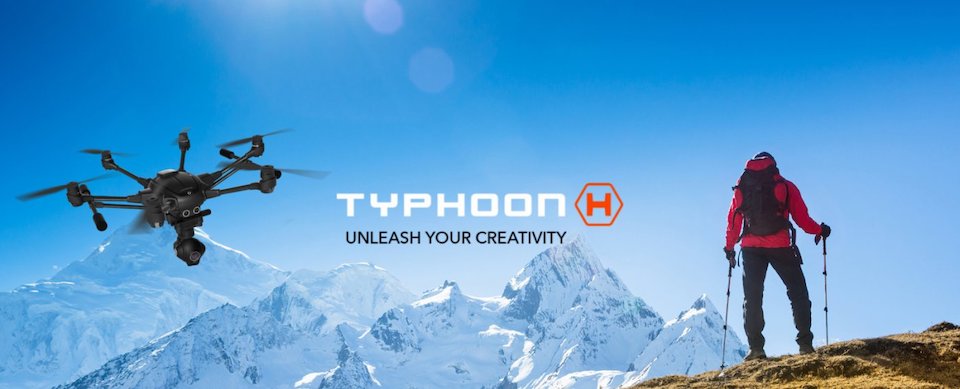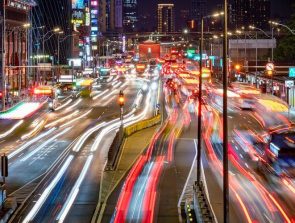An In-Depth Review of the Yuneec Typhoon H
When the Yuneec Typhoon H was announced back in 2016, it caught a lot of attention for looking very similar to the super popular Inspire 1 drone from DJI. It also had some of the best features of the Inspire 1 such as the retractable landing gear and a full 360-degree rotating camera. Best of all, it came out at a much lower price than the Inspire 1.
More than two years after the launch, we take a detailed look at what made the Typhoon H one of the most popular drone of its time. Did the Typhoon H age well and does it still compare favorably to today’s more modern models?
Design
The first thing that sets the Typhoon H apart is its hexacopter design. Instead of the usual for rotors, the Typhoon H has six. The great thing about this design is that the Typhoon H only needs five to fly – the sixth is redundant. This means that even when you lose a propeller or motor in the middle of the flight, the Typhoon H can still safely fly back home. This gives the Typhoon H a level of reliability that cannot be equaled by any quadcopter.
The hexacopter design has proved to be a hit for Yuneec, who has proceeded to make it the signature look of all the succeeding Typhoon drones, such as the Typhoon H Plus and the Typhoon H520.
The rotor arms of the Typhoon H fold downwards for easier storage and transportation. Even in its folded form, it is still slightly bigger than a Phantom 4, so the Typhoon H is by no means a portable drone. However, you should not have problems putting the Typhoon H into a hard case and throwing it into your car’s trunk or backset.
The downside of having foldable rotor arms is that they can also act as weak points. The rotor arms themselves are made of lightweight but durable carbon fiber which can likely withstand a few rough tumbles. However, the hinges where the rotors fold in do not seem as rugged.
Another feature that of the Typhoon H that reminds us of the Inspire 1 is its retractable landing gear. The landing gear automatically folds up when you take off, completely getting out of the way of the onboard camera’s field of view. This allows the camera to completely pan through 360 degrees without any obstruction. A retractable landing gear makes it easier to capture aerial photos and videos, as the drone no longer needs to be maneuvered around to get the perfect angle.
Camera
The camera of the Typhoon H, called the CGO3+, has 1/2.3-inch CMOS sensor that can capture 12.4 MP stills. It also boasts of slow-motion capabilities, as it can capture 4K video at 30 fps and 1080p video at 60 fps. With a bigger sensor and faster processor, the camera of the Typhoon H is a worthy upgrade to that of its predecessor, the Typhoon Q500 4K.
On its own, the CGO3+ has an impressively wide 115-degree field of view. This is further enhanced by a 3-axis gimbal that has limitless 360-degree panning and a pitch that can go from 0 to -90 degrees. Such a wide range of motion has only been seen previously with the DJI Inspire 1, and greatly enhances the capabilities of the CGO3+ camera.
The only lackluster part of the Typhoon H camera is its mounting mechanism. The camera is mounted onto the drone using plastic rails that do not seem to be very sturdy or secure. This is not likely a problem early in the drone’s life, but we could see it becoming more of an issue as it undergoes normal wear and tear.
Remote Controller
The Typhoon H comes with the ST16 remote controller with an integrated 7-inch Android-based 720p display. This eliminates the need to use your mobile phone for real-time video feed and telemetry data. The ST16 has an excellent user interface that allows you to control a wealth of flight and camera settings. It is very intuitive and responsive and could probably give the DJI remote controllers a run for their money.
The ST16 also has an HDMI port so you can easily connect FPV goggles or an external monitor for better viewing of the real-time video. The transmission range for both the video downlink and control is around 1 mile.
The biggest drawbacks to the ST16 remote controller are its unwieldy size and the fact that all the different controls may prove overwhelming for beginners. There is a bit of a learning curve before you can fully grasp all the capabilities of the ST16 remote controller, more so than in the Inspire 1 or Phantom 4. However, you will enjoy a greater degree of control over the Typhoon H once you gain mastery of the ST16.
Obstacle Avoidance
The base model of the Typhoon H comes with a front-facing sonar sensor that allows it to detect and avoid obstacles in the forward direction. The use of sonar technology is admirably innovative, as it allows the drone to “see” obstacles even in darkness.
Yuneec also offers an upgraded version of the Typhoon H which can be augmented with the Intel RealSense obstacle avoidance technology. This system uses the Intel RealSense R200 camera to continuously build a 3D model of its surroundings, allowing the drone the intelligently navigate around obstacles. It even has the capability to remember its environment, so it will keep on avoiding an obstacle that it has avoided repeatedly.
The advanced obstacle avoidance technology of the Typhoon H (especially the upgraded version) allows drone photographers to focus on their subject without having to worry too much about crashing their drone. Its GPS-based tracking system also allows it to track subjects even when they get away from visual range.
Flight Performance
With its hexacopter design, the flight stability of the Typhoon H is probably one of the best in the prosumer drone category. Aside from having a redundant rotor, the propeller motors of the Typhoon H also have a brushless design, which are known for very low failure rates.
It takes some time to get used to flying the Typhoon H. Considering the aforementioned complexity of the ST16 remote controller, the Typhoon H is not a drone we would recommend to beginners. However, features such as its obstacle avoidance technology, automatic take-off and return-to-home, and haptic feedback on the remote controller all combine to make the flying experience a little easier.
The Typhoon H offers two flight modes: Angle and Smart. In Angle mode, the drone moves in the direction of the control stick relative to the nose of the drone. Smart mode is basically “headless” mode, which always moves the drone at a direction relative to the pilot. Although this feature is quite common, we still appreciate how this accommodates pilots of different skill levels.
A very nifty feature of the Typhoon H is its ability to link to two different ST16 remote controllers at the same time. In “Team mode”, one remote controller has the task of flying the drone while the other controller focuses on camera movements and shots. This is a very useful feature for professional drone photographers and filmmakers. At the time of its release, the Typhoon H was the only drone to offer this feature.
Battery
The Typhoon H comes with a 14.8V 5400 mAh LiPo battery which allows the drone to fly up to 25 minutes on a single battery cycle. This is likely measured under ideal conditions and may be reduced to as low as 20 minutes with more demanding flight and camera loads.
Charging the battery from empty to full takes a little over two hours, which is considerably longer than the charging time of the Phantom 4 or Inspire 1 batteries. For commercial photographers who are planning on using the Yuneec Typhoon H, it would be prudent to get a couple of extra batteries and probably a multi-battery charging dock.
Flight Modes
As with some of the best professional camera drones, the Typhoon H comes with a suite of creative automated flight modes that allow drone filmmakers to capture unique shots. This includes the standard Follow Me, Journey, and Point of Interest modes.
The Curve Cable Cam (CCC) mode is probably the best flight mode that the Typhoon H offers. Using its onboard GPS technology, the Typhoon H can fly along an imaginary cable line determined by preset GPS coordinates. The drone continues to fly along this path while the camera can be controlled independently, giving you full freedom to capture all the stills and videos you like. The drone’s obstacle avoidance technology is still engaged while flying in CCC mode, so you need not worry about running into obstacles.
Price
Being an old model, the price of the Typhoon H has dropped by a huge amount since its release. The base Typhoon H model now costs less than $1000 – a quarter of the cost of a DJI Inspire 1 and around the same price as the original Phantom 4.
The upgraded Typhoon H with Intel RealSense costs around $1500 in Amazon, which is comparable to a DJI Phantom 4 Pro +. It is still much cheaper than an Inspire 1.
Is it still worth it?
The original Typhoon H can still be considered one of the best professional camera drones, despite the release of its upgraded version, the Typhoon H Plus. Although its 12.4MP still resolution seems very dated, it is still capable of capturing 4K video which is good enough for most filmmaking applications. It’s also rare to get a drone that offers full 360-degree rotation at the price tag of a Typhoon H.
The Typhoon H is one of the most reliable and safest drones in the market, largely due to its six-rotor design with brushless motors. Its unique look makes it stand out from all other drones in the same price range. If you’re a professional drone photographer, then the Typhoon H is an excellent drone that won’t break the bank.
The Typhoon H model with Intel RealSense is a very good upgrade but also comes at a much higher price. Considering that its price is comparable to that of the DJI Phantom 4 Pro and Pro+, we find it hard to recommend getting the upgraded Typhoon H. After all, the Phantom 4 Pro also comes with an excellent 5-direction obstacle avoidance system and a better 1-inch 20MP camera.
There have been issues with the build quality and durability of some of the plastic parts of the Typhoon H. Some of the components, such as the camera mount and the hinge of the landing gear, appear to break down earlier than expected. It’s not all bad, though, as spare parts for the Typhoon H are very affordable and are easily available from Yuneec. In any case, Yuneec offers excellent customer service and after-sales report should you run into problems with your Typhoon H.


